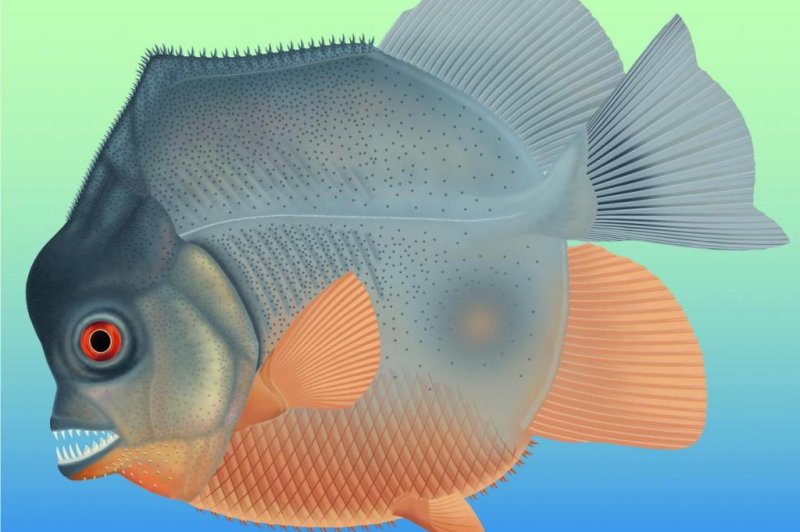An illustration shows what the new piranha-like species might have looked like. Photo by The Jura-Museum, Eischstatt, Germany
Oct. 18 (UPI) -- Scientists have identified a 150-million-year-old fossil as a new species and the earliest-known flesh-eating fish.
The specimen was recovered from Germany's Solnhofen Limestone. During the Late Jurassic, the limestone deposit abutted the Tethys Sea, the body of water that separated the ancient continents of Gondwana and Laurasia.
Scientists used advanced imaging to analyze the piranha-like fish. The anatomical analysis revealed a jaw and teeth capable of chomping on the fins of other fish.
Researchers discovered long, pointed teeth protruding from the upper and lower jaw, as well as triangular, serrated teeth along the sides of the lower jaw.
"The dentition pattern, tooth shape, jaw morphology, and mechanics are all indicative of a feeding apparatus suitable for slicing flesh or fins, thus pioneering a new ecological niche," scientists wrote in the journal Current Biology.
Victims of the novel predation strategy were also unearthed by the team of paleontologists.
"We have other fish from the same locality with chunks missing from their fins," David Bellwood, researcher at James Cook University in Australia, said in a news release. "This is an amazing parallel with modern piranhas, which feed predominantly not on flesh but the fins of other fishes. It's a remarkably smart move as fins regrow, a neat renewable resource. Feed on a fish and it is dead; nibble its fins and you have food for the future."
The discovery raises questions about how a new feeding strategy evolves. According to researchers, the new species' closest relatives deployed broad teeth capable of crushing -- not slicing and dicing.
"It is like finding a sheep with a snarl like a wolf," said Martina Kölbl-Ebert, researcher at the of Jura-Museum Eichstätt, where the specimen is housed.
Scientists suggest the newly described species is proof of the tremendous versatility made possible by evolution.
"The new finding represents the earliest record of a bony fish that bit bits off other fishes, and what's more it was doing it in the sea," Bellwood said.
Modern piranhas are only found in freshwater.
"So when dinosaurs were walking the earth and small dinosaurs were trying to fly with the pterosaurs, fish were swimming around their feet tearing the fins or flesh off each other," he said.















